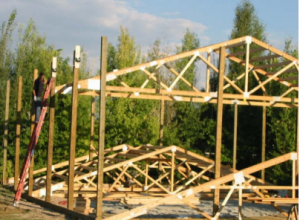Why Build the Roof Before Walls?
Sometimes I can get so deep into a forest I cannot see trees – I miss things which should be otherwise obvious.
For whatever reason a client contacted his Hansen Pole Buildings’ Designer, rather than first contacting Technical Support. Building Designer Gregg aptly forwarded client’s request directly to our Technical Support team:
“….who has already purchased, he had a question from the manual on what size (diameter) rebar to use on the corner post, according to attached photo. He also wanted to know if he could put in girts before he places trusses, as the everything else arrived except for trusses so far, the manual says do trusses first.”
Mike the Pole Barn Guru writes:
Last half portion of client’s request is what pushed my “McFly” button!
Please refer to Detail in upper left corner of sheet S-2 of your engineered plans (plan view at corner columns) and Chapter 7 of Construction Manual.
Rebar is measured in 1/8th inch diameters, therefore a #4 rebar is 1/2″ diameter (four divided by eight).
We strongly recommend you frame roof prior to placing wall girts.
In reading through the Construction Manual today, I find (very beginning of Chapter 19: Girts) where it says, “Prior to installing ANY wall framing, return to Chapters 13 through 17 to insulate and put steel on roof.” This seems to be an issue of challenge to people – not just do-it-yourselfers, but also those who portray themselves to be construction professionals. We tell installers not to, but do not explain why. Here goes:
Trusses extend from a minimum of outside of column to outside of column (not to mention any overhangs). If walls have been framed (girts, headers and door jambs placed) trusses will have to be jockeyed around to be lifted in place from inside of building.
 A great majority of post frame buildings have one or more columns not perfectly placed along building length. Accept it, this is just going to happen no matter how perfect you or your builder might be. Most buildings have a far greater number of roof purlins per bay, than wall girts per bay. By framing roof first, all purlins can be cut to same length in each bay, this is determined by engineered plan column spacing, less thickness of truss assemblies. When trusses are in place, tops of columns will easily move forward or backwards so all truss supporting columns end up spaced per plans. This also aids in creation of an overall building roof length matching expectations.
A great majority of post frame buildings have one or more columns not perfectly placed along building length. Accept it, this is just going to happen no matter how perfect you or your builder might be. Most buildings have a far greater number of roof purlins per bay, than wall girts per bay. By framing roof first, all purlins can be cut to same length in each bay, this is determined by engineered plan column spacing, less thickness of truss assemblies. When trusses are in place, tops of columns will easily move forward or backwards so all truss supporting columns end up spaced per plans. This also aids in creation of an overall building roof length matching expectations.
During truss placement process (regardless of method used) there will come times when it is highly convenient to be able to walk ‘through’ a wall. Girts in place means having to fit through girts or walk around the building walls- either one slows the construction process.
It is far easier to square up a roof without resistance of wall framing members. Once roof sheathing or roof steel is in place, it makes it far easier to plumb building corners.
With roofing in place and walls open, a concrete slab may be installed if desired. Having the roof completed before wall girts are in place helps protect concrete pour from weather elements, especially rain or heat in summer. Pre-mix trucks can access and chute through any accessible sides or ends. This can negate needs to pay for a pump truck.






